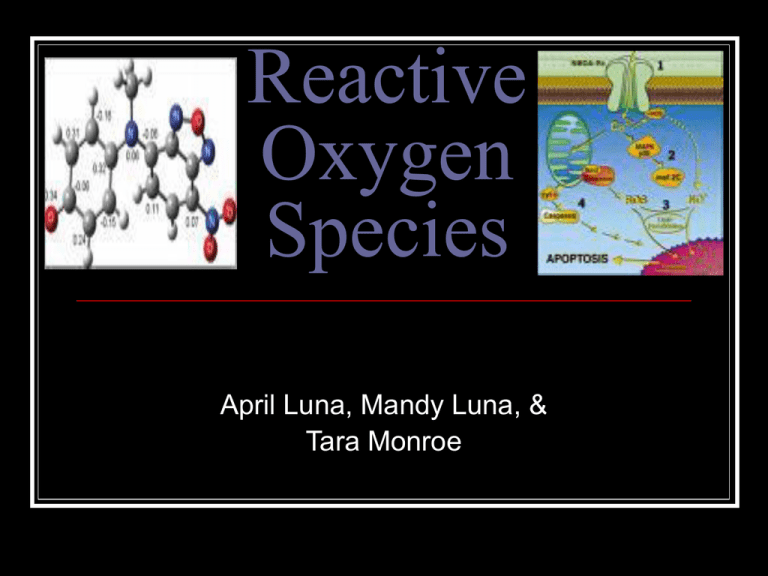Reactive Oxygen Species
advertisement

Reactive Oxygen Species April Luna, Mandy Luna, & Tara Monroe What is Reactive Oxygen Species? Reactive Oxygen Species or ROS is defined as molecules or ions formed by the incomplete one electron reduction of oxygen ROS are highly reactive due to unpaired valence shell electrons What is Reactive Oxygen Species? Reactive Oxygen Intermediates include: Singlet Oxygen Superoxides Peroxides Hydroxyl Radical Hypochlorous Acid Where does ROS come from? What does it do? Reactive Oxygen Species form as a natural byproduct of the normal metabolism of oxygen ROS is involved in: Microbial activity of Phagocytes Regulation of signal transduction Regulation of gene expression Oxidative damage to nucleic acids, proteins, and lipids What is the importance of ROS? Bad vs. Good ROS – good plays a role in the induction of host defense genes Platelets involved in wound repair release ROS to recruit additional platelets to an injury site What is the importance of ROS? Bad vs. Good ROS- bad Implicated in apoptosis, or programmed cell death Large amounts of ROS can cause DNA damage in the cell which can lead to cancer * Cells have a variety of defenses to protect themselves from ROS, including two main enzymes. In the next slides, we will discuss: - ROS and its involvement with antibiotics - ROS and its involvement in cancer - The different effects ROS has on humans and mice ROS in the presence of antibiotics… In an article discussing the action of antibiotics it was found that the production of ROS is a mechanism of cell death that is induced by bactericidal antibiotics In contrast, bacteriostatic antibiotics do not cause ROS formation ROS in the presence of antibiotics… Respiration in aerobic organisms results in the formation of ROS which has been implicated in the action of certain antibiotics. It was also found that ROS is produced in E. coli by the action of what is known as antibioticinduced mazEF-mediated cell death… mazEF mediates two cell death pathways, ROSdependent and ROS-independent. How does ROS interact with antibiotics? In some cases, ROS is produced as a byproduct of antibiotic induced cell death in bactericidal antibiotics In an article discussing amoxicillin and ROS it was found that Reactive Oxygen Species cause amoxicillin to produce oxidative damage of DNA in mammalian cells ROS and Amoxicillin Studies have shown that amoxicillin stimulates the ROS at the same pace as the DNA lesion induction. ROS in mammalian cells cause the amoxicillin to produce oxidative DNA damage. ROS increased 10 minutes after the intake of amoxicillin. ROS may help mediate several inflammatory diseases, But if taken with amoxicillin, the ROS increases thereby producing DNA damage. The Connection between ROS and DNA lesions DNA lesions are caused by damage to bases during DNA synthesis. This damaged base often causes disincorporation at the lesion site. These mismatches have increased susceptibility to form unpaired bases. Such DNA lesions are often caused by amoxicillin leading to stimulation of the ROS at the same pace as the DNA lesion induction. What does ROS and Tetracycline HCl do when put together? Tetracycline HCL is an antibiotic that is often used in the treatment of acne When used, it was found that this antibiotic reduces/inhibits some ROS generation from zymosan-stimulated polymorphonuclear leukocytes (PMNL). Erythromycin also inhibits ROS in the same way Do other antibiotics have the similar effect on ROS? Some antibiotics such as erythromycin and tetracycline HCL reduce ROS generation. Cephalexin, penicillin G, streptomycin, and chloramphenicol have no inhibitory effect on ROS at tested concentrations Therefore, certain antibiotics have the ability to inhibit ROS generation by PMNL while others do not When are these antibiotics used and for what? ROS-inhibiting antibiotics are used for: Resolving inflammatory acne lesions by acting directly on PMNL as antioxidants A combination of tetracycline HCL and ibuprofen is an effective treatment for moderate acne How does ROS production and cancer link together? ROS and Cancer In a recent article researchers analyzed 10 human prostate cancer microarray data sets. Researchers determined: In the cell increased ROS level or decreased antioxidant levels can lead to the ROS damaging lipids, proteins and DNA Nrf2 and members of the glutathione-S-transferase family decrease tremendously in the presence of ROS. DNA has extensive protection of cellular antioxidants and detoxification enzymes. But even with these protections, alterations occur causing cellular transformation. ROS and Cancer The loss of Nrf2 causes a decrease in GST expression and increased levels of ROS. This ultimately leads to DNA damage associated with tumorigenesis. (Erythroid 2p45 (NFE2) related factor 2 (Nrf2) is a basic region leucine zipper transcription factor that mediates gene expression through the antioxidant response ele ment. ) These studies suggest that if researchers can find a way to maintain or enhance Nrf2 expression or activation, it can lead to a new chemo-preventative strategy for prostate cancer. The different reaction ROS has on human cells and mice In mice: DNA and proteins are damaged by oxidation during tumor progression. There have been similar results in the transgenic adenocarcinoma of the prostate, where increased oxidative and nitrosative damage was shown in the prostate gland during tumorigenisis. – Expression of SV40 TAg and TAg antigens result in three pocket proteins losing all functionality which directly leads to prostate cancer. The different reaction ROS has on human cells and mice In humans: Nrf2 is down-regulated in prostate cancer The loss of Nrf2 results in reduced expression and reduced activity of GST enzymes which leads to increased ROS thereby increasing DNA damage resulting in tumorigenisis. Conclusion ROS (Reactive Oxygen Species): Chemical species that are formed upon incomplete reduction of Oxygen and a common mechanism of cell death induced by bactericidal antibiotics. Importance: Mediate the toxicity of oxygen and also operate as intracellular signaling. High levels of ROS has been shown to increase DNA damage. Conclusion ROS and Antibiotic Interactions: Tetracycline HCL and Erythromycin inhibit some of the ROS production by polymophonuclear leukocytes (PMNL). In acne, the antibiotics used for treatment reduce the ROS generation from PMNL. Other antibiotics don’t have an inhibitory reaction to ROS. Conclusion ROS and Amoxicillin: Amoxicillin stimulated the ROS at the same pace as the DNA lesion induction. ROS in mammalian cells cause the amoxicillin to produce oxidative DNA damage. ROS increased only after 10 minutes after the intake of amoxicillin. ROS may help mediate several inflammatory diseases, but if taken with amoxicillin, the ROS increases and produces DNA damage. It is good and bad, depends on what antibiotic is taken. Conclusion ROS and cancer: High ROS levels have shown to produce DNA damage and tumorigenesis. Nrf2(a basic-region leucine zipper transcription factor) is activated by elevated ROS and is currently being highly researched. The Nrf2 is down regulated in prostate cancer and is important for treatment. Decreased Nrf2 means an elevated ROS and DNA damage. Conclusion ROS Future Research: ROS signaling and homeostasis and their roles in aging is not currently known. The biology and biochemistry of ROS is currently being studied, but is hard because of the numerous cellular effects it has. The genetic description of the cellular and organism mechanisms of ROS tolerance is needed. The process ROS and antibiotics interactions and what makes certain antibiotics inhibit or increase ROS levels. The technique that ROS uses to damage DNA and increase turmorigenesis. References Kolodkin-Gal, I., Sat, B., and Kesh, A., and Engleberg-Kulka, H. Dec. 2008.The communication factor EDF and the toxinantitoxin module mazEF determine the mode of antibiotics. PLoS Biology 6:e319 Miyachi, Y., Yoshioka, A, and Imamura, S., and Niwa, Y. 1986.Effect of Antibiotics on the Generation of Reactive Species. Page 449-453. Li, P., Chang, Y., and Tzang, B., and Chen, C., and Liu, Y. 2007. Antibiotic amoxicillin induces DNA lesions in mammalian cells possibly via reactive oxygen species. Mutation Research 629: 133-139. Frohlich, D.D., McCabe, M.T., and Arnold, R.S., and Day, M.L.2008. The role of Nrf2 in increased reactive oxygen species and DNA damage in prostate tumorigenesis. Oncogene 27:4353-4362. Aurreauz, B.D. and Toledano, M.B. 2007. ROS as signaling molecules: mechanisms that generate specificity in ROS homeostasis. Nature Reviews 8: 813-824. http://search.aol.com/aol/image?invocationT ype=rboxImgDtls&query=reactive%20oxyge n%20species&icid=snap-pic&flv=1. The End






